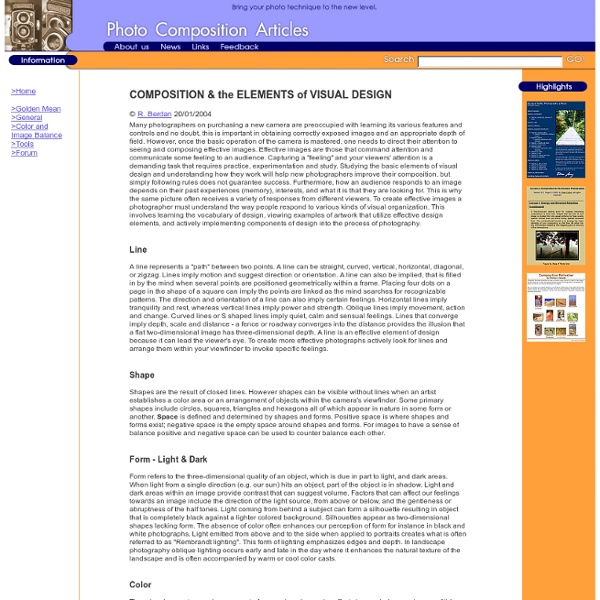Composition and the Elements of Visual Design
Proportion - Golden Ratio and Rule of Thirds Proportion refers the size relationship of visual elements to each other and to the whole picture. One of the reasons proportion is often considered important in composition is that viewers respond to it emotionally. Proportion in art has been examined for hundreds of years, long before photography was invented. Many photographers and artists are aware of the rule of thirds, where a picture is divided into three sections vertically and horizontally and lines and points of intersection represent places to position important visual elements. On analyzing some of my favorite photographs by laying down grids (thirds or golden ratio in Adobe Photoshop) I find that some of my images do indeed seem to correspond to the rule of thirds and to a lesser extent the golden ratio, however many do not.
Principles of Design
What is good visual design? “As little design as possible,” according to influential designer, Dieter Rams. However, what Rams does not explain is that good visual design needs foundation—principles that are followed rigorously to accommodate innovation and aesthetic. At Impekable, we, too, have adopted design principles to reach what Dieter Rams calls “good design.” Good design is as little design as possible. Consistency Consistency means creating an interface that fits together in a family of different resolutions and mobile apps—making sure that the same elements are being repeated to match each page. You’d be able to recognize Facebook’s branding anywhere. Alignment Alignment is when two elements are connected by an invisible path or a visual connection. Twitter has two notable columns in their web app. Lined up and pretty. Proximity Elements need to be grouped in a logical manner. Put a grid on it! Contrast Contrast happens when two related elements are different. See that button?
The Official 'Successful Website Checklist Challenge'
If your website doesn't stand out and do a heck of a lot of things right, then chances are it's going to crash and burn. Take our "Successful Website Checklist Challenge" (below) and see what you're doing right, what you're doing wrong, and what you're forgetting to do. We've even included notes and resources for nearly every item on the checklist (just to make your life easier). This page doubles as a comprehensive article/checklist. Although, by default, descriptions and notes under all of the checklist items are visible, you can hide them. Although our "Successful Website Checklist" is pretty thorough, we consider it a work in progress.
Visual Design Basics
Visual design focuses on the aesthetics of a site and its related materials by strategically implementing images, colors, fonts, and other elements. A successful visual design does not take away from the content on the page or function. Instead, it enhances it by engaging users and helping to build trust and interest in the brand. Basic Elements of Visual Design The basic elements that combine to create visual designs include the following: Lines connect two points and can be used to help define shapes, make divisions, and create textures. Principles for Creating a Visual Design A successful visual design applies the following principles to elements noted above and effectively brings them together in a way that makes sense. Unity has to do with all elements on a page visually or conceptually appearing to belong together. Example of Pulling it all together Additional Information
Clean Up Your Mess - A Guide to Visual Design for Everyone
Related:
Related:



